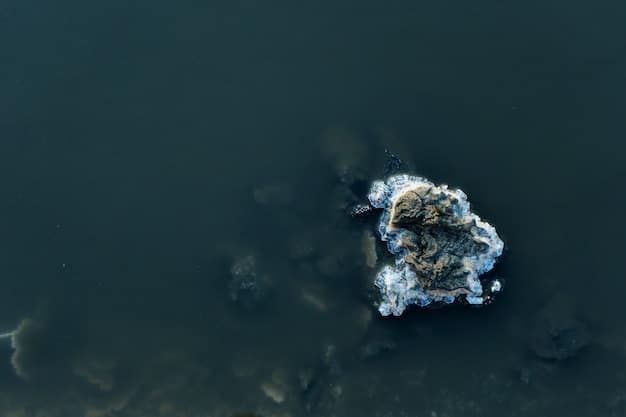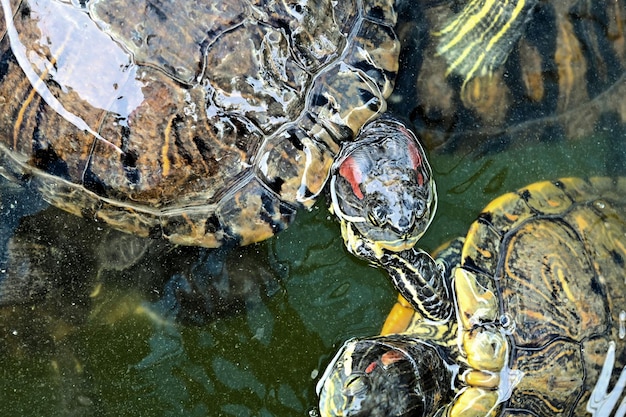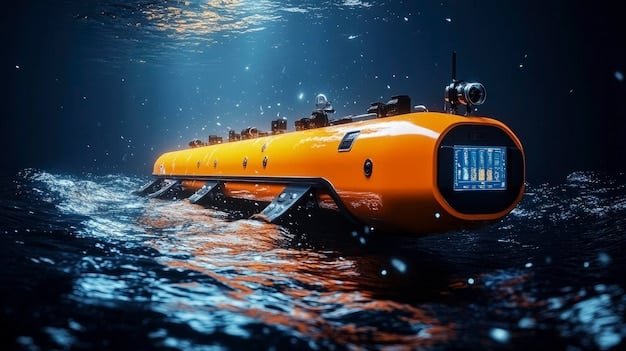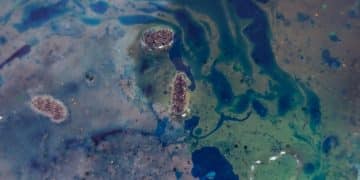Latest Research on Oil Spills’ Impact on US Marine Life

The latest research on the impact of oil spills on marine life in the US reveals complex, long-term ecosystem disruptions, bioaccumulation of toxins, and nuanced effects across species, emphasizing the continued need for advanced mitigation and conservation strategies.
The vast and dynamic marine ecosystems across the United States are critical to global biodiversity and economic stability. Yet, these vital environments face persistent threats, none perhaps as devastating and far-reaching as oil spills. Understanding what are the latest research findings on the impact of oil spills on marine life in the US is crucial for effective conservation, policy-making, and public awareness.
Understanding the Immediate and Long-Term Ecological Fallout
Oil spills, whether from offshore drilling accidents, shipping collisions, or pipeline ruptures, introduce a complex mixture of hydrocarbon compounds into marine environments. The immediate effects are often dramatic and visible, but the long-term consequences, often subtle and insidious, pose a far greater challenge for ecological recovery.
Recent studies have moved beyond simply observing direct mortality to analyzing the intricate ways oil disrupts biological processes at cellular and molecular levels. This deeper understanding reveals chronic sub-lethal effects that can compromise marine life for generations.
Acute Toxicity and Behavioral Changes
When marine organisms come into contact with crude oil or refined petroleum products, the immediate response is often highly toxic. Fish, marine mammals, and birds can suffer from external oil coating, which leads to hypothermia, entanglement, and loss of buoyancy. Internally, ingestion or inhalation of oil components can cause acute organ damage, immune suppression, and neurological disorders.
Behavioral changes are also common. For instance, fish exposed to oil may exhibit erratic swimming patterns, leading to impaired foraging abilities or increased vulnerability to predators. Marine mammals, like dolphins and whales, might alter migration routes or feeding grounds, stressing their populations further.
- Direct Mortality: From coating of feathers/fur, ingestion, and acute organ failure.
- Physiological Stress: Increased metabolic rates, reduced growth, and impaired reproduction.
- Behavioral Disruption: Changes in foraging, migration, and predator avoidance.
Beyond the immediate aftermath, the acute period of a spill sets the stage for chronic issues. Organisms that survive direct exposure may carry internal damage that manifests much later, affecting their long-term health and reproductive success. This delayed impact often complicates recovery efforts and makes it challenging to draw a clear line between the spill and subsequent population declines.
Sub-lethal and Chronic Impacts
The true legacy of an oil spill often lies in its sub-lethal and chronic impacts. These are not always immediately apparent mortality events but rather long-term health issues that can weaken populations over time. Recent research highlights effects like impaired immune function, decreased reproductive success, and behavioral alterations that persist for years or even decades after the oil is seemingly “gone.”
Studies following major spills, such as the Deepwater Horizon incident, have shown marine species developing heart abnormalities, liver lesions, and endocrine disruption. For example, some fish species in the Gulf of Mexico exhibited heart defects and reduced swimming performance, impacting their ability to escape predators or find food. These chronic conditions can lead to reduced fitness, making populations more vulnerable to other environmental stressors.
The complexity of these chronic effects demands interdisciplinary research, combining toxicology, ecology, and genomics, to fully grasp the extent of the damage. Understanding these long-term ramifications is pivotal for shaping restoration projects and informing preventative measures against future spills.
Bioaccumulation and Food Web Contamination
One of the most insidious effects of oil spills is the way petroleum hydrocarbons enter the marine food web. Unlike physical coating, which can eventually dissipate, the chemical components of oil can be absorbed by organisms and then transferred up the trophic levels, affecting species far removed from the initial spill site. This process, known as bioaccumulation, has profound implications for ecosystem health and human consumption of seafood.
Hydrocarbons can persist in the environment, especially in sediments, for years. Bottom-dwelling organisms, like clams and worms, ingest these contaminants. When these organisms are eaten by larger predators, the toxins are transferred and often become more concentrated at each successive level of the food chain, a phenomenon called biomagnification.
Tracing Hydrocarbons Through Marine Life
New research methods allow scientists to trace specific oil compounds through various marine species. Techniques like gas chromatography-mass spectrometry (GC-MS) coupled with stable isotope analysis enable researchers to identify the source of the hydrocarbons and track their movement from affected areas into the tissues of fish, shellfish, birds, and marine mammals.
For instance, post-Deepwater Horizon studies found elevated levels of polycyclic aromatic hydrocarbons (PAHs), a particularly toxic component of crude oil, in a wide range of species across the Gulf of Mexico. This included commercially important fish, underscoring risks not only to ecosystem health but also to fisheries and human consumers.
- Sediment Contamination: Oil settling in seabed sediments acts as a long-term reservoir of toxins.
- Benthic Ingestion: Bottom-dwellers consume contaminated sediments, initiating food web transfer.
- Trophic Transfer: Toxins accumulate as they move up the food chain, affecting higher predators.
The continued presence of these contaminants in the food web means that even years after a spill, marine life is still consuming affected prey. This constant exposure can lead to chronic health problems, genetic mutations, and reproductive failures in top predators, including endangered marine mammals and seabirds, creating a slow-burning ecological crisis.

Impact on Human Health and Economy
Beyond the direct ecological consequences, the bioaccumulation of hydrocarbons has significant implications for human health and coastal economies. Fisheries closures are a common immediate response to large oil spills, but the lingering concern of contaminated seafood can affect consumer confidence and market prices for years, even after fishing bans are lifted.
Research on the long-term presence of oil residues in commercially harvested species raises questions about the health risks associated with consuming seafood from previously oiled areas. Authorities typically monitor seafood for safety, but public perception and the financial well-being of fishing communities can be severely impacted long after visible cleanup operations conclude.
The economic fallout extends beyond fisheries to tourism and recreation. Beaches and coastal areas affected by spills can lose their appeal, leading to declines in visitor numbers and associated economic activity. Recovering from this reputational damage can take immense effort and investment, highlighting the interconnectedness of environmental health, economic vitality, and human well-being.
Species-Specific Vulnerabilities and Resilience
The narrative of oil spill impacts is not uniform across all marine life. Different species exhibit varying degrees of vulnerability and resilience to oil exposure, depending on their physiology, life history, habitat, and behavioral patterns. Understanding these specific responses is crucial for targeted conservation and rehabilitation efforts.
Recent scientific endeavors have focused on drilling down into how particular species or groups respond to oil, moving beyond generalized statements to nuanced, empirically-supported findings. This includes assessing genetic predispositions, recovery mechanisms, and the success rates of various intervention strategies.
Marine Mammals: Unique Challenges
Marine mammals, including whales, dolphins, seals, and manatees, face distinctive threats from oil spills due to their reliance on blubber for insulation, their respiratory physiology, and complex social structures. Direct oiling of fur (in seals and sea otters) can lead to hypothermia and loss of buoyancy, while ingestion of oil during foraging or grooming can cause gastrointestinal damage, organ failure, and neurological issues.
A significant area of ongoing research concerns the long-term reproductive impacts on marine mammal populations. Post-spill studies have linked oil exposure to increased rates of miscarriage, stillbirths, and health problems in calves, severely impacting the recovery capacity of already vulnerable or endangered populations. The Deepwater Horizon spill, for example, heavily impacted bottlenose dolphins in the Gulf, with ongoing research revealing higher rates of lung disease and adrenal dysfunction.
Furthermore, marine mammals often inhabit large ranges, meaning oil can impact them across vast distances, disrupting migratory paths or critical feeding areas. Behavioral changes due to oil can also compromise their ability to vocalize, navigate, and forage effectively, leading to cascading effects on their survival.
Avian Species: High Vulnerability
Seabirds are among the most visibly affected victims of oil spills. Their feathers, when coated with oil, lose their waterproofing and insulating properties, leading to hypothermia, buoyancy loss, and eventual drowning or starvation. Birds also ingest oil when attempting to preen their contaminated feathers, leading to severe internal damage, including liver disease, kidney failure, and reproductive toxicity.
Research has focused on understanding the different responses of various bird species. Diving birds, like loons and murres, are particularly vulnerable as they spend much of their time on or in the water, increasing their exposure risk. Raptors and scavengers that feed on oiled carcasses can also suffer secondary poisoning.
- Feather Fouling: Leads to hypothermia, reduced buoyancy, and impaired flight.
- Ingestion Toxicity: Causes internal organ damage, immune suppression, and reproductive failure.
- Habitat Degradation: Contamination of nesting and feeding grounds disrupts breeding cycles.
Long-term studies have shown that even apparently recovered bird populations can exhibit reduced breeding success and higher mortality rates years after a spill. This highlights the persistent sub-lethal effects that continue to weaken populations, making full recovery a protracted and challenging process.
Ecosystem-Level Impacts and Recovery Dynamics
Oil spills do not just affect individual organisms; they trigger complex cascades of impacts throughout entire ecosystems. Understanding these ecosystem-level dynamics, including trophic cascades, habitat degradation, and the resilience of different habitats, is essential for predicting the full scope of damage and planning comprehensive restoration.
Recent research is moving towards a more holistic view, examining how oil spills alter fundamental ecosystem processes, from nutrient cycling to primary productivity, and how these changes ripple through interconnected food webs and habitats.
Habitats Under Threat: Estuaries, Coral Reefs, and Deep Sea
Different marine habitats possess varying sensitivities and recovery capacities when confronted with oil. Estuaries and salt marshes, with their intricate network of roots and sediments, can trap oil, making cleanup difficult and prolonging exposure for resident species. Oil-soaked marsh grasses can die, leading to erosion and long-term habitat loss.
Coral reefs, vibrant hubs of marine biodiversity, are also highly vulnerable. Oil can smother polyps, reduce light penetration, and introduce toxic compounds, leading to coral bleaching, disease, and death. Recovery of coral reefs is notoriously slow, often taking decades or even centuries.
The deep sea, once thought to be relatively immune to surface spills, is now recognized as a significant sink for oil and oil-dispersant mixtures. Research from the Deepwater Horizon spill revealed extensive damage to deep-sea coral communities and associated fauna, with slow recovery observed due to the cold temperatures and slow metabolic rates of deep-sea organisms.
These studies emphasize that damage extends far beyond the surface, reaching the most remote and sensitive parts of the ocean, often with unseen and long-lasting consequences. Each habitat requires specific understanding and tailored restoration approaches to maximize its chance of recovery after an oil spill.
Advanced Monitoring and Mitigation Technologies
The devastating effects of past oil spills have spurred significant advancements in both monitoring technologies and mitigation strategies. Current research focuses on developing more precise tools for detecting oil, predicting its movement, and implementing more effective and less environmentally damaging cleanup methods.
From satellite imagery to advanced sensor networks, the ability to respond to and assess spills has vastly improved. Concurrently, efforts are underway to refine traditional cleanup techniques and explore novel biological and chemical approaches to oil remediation, seeking to minimize secondary impacts from the cleanup itself.
Remote Sensing and Real-Time Tracking
One of the most significant strides in spill response has been the integration of remote sensing technologies. Satellites equipped with synthetic aperture radar (SAR) and optical sensors can detect oil slicks over vast oceanic areas, providing crucial real-time data on spill location, extent, and movement. This information is vital for deploying response teams rapidly and effectively.
Drones and unmanned aerial vehicles (UAVs) are increasingly used for closer-range monitoring, offering high-resolution imagery and even collecting samples. These technologies provide agility and precision, allowing responders to assess conditions in remote or hazardous areas without putting human lives at risk. Combined with oceanographic modeling, these tools help predict oil trajectory, enabling pre-emptive protection of sensitive coastal areas.
- Satellite Imagery: Broad-area detection and tracking of oil slicks.
- Drone Surveillance: High-resolution assessment of affected areas and wildlife.
- Oceanographic Modeling: Prediction of oil movement to guide response efforts.
The integration of these real-time data streams into decision-making frameworks is transforming spill response from a reactive to a more proactive and strategically informed effort. The accuracy of these predictions, however, still relies heavily on comprehensive environmental data and sophisticated algorithmic processing.

Bioremediation and Dispersants: Ongoing Research and Debates
Cleanup technologies continue to evolve, often sparking debate. Bioremediation, which involves using microorganisms to break down oil, is gaining traction. Research explores enhancing natural bacterial populations or introducing specialized microbes to accelerate oil degradation, particularly in hard-to-reach areas or after mechanical removal.
Conversely, the use of chemical dispersants remains a contentious issue. While dispersants break up oil slicks into smaller droplets, making them less visible and potentially more available to natural degradation, concerns persist about their toxicity to marine life and their potential to facilitate the deep-water transport of oil components. Recent studies are investigating the combined toxicity of oil and dispersants, aiming to develop less harmful alternatives and establish clearer guidelines for their application.
Other traditional methods, such as booming, skimming, and in-situ burning, are continually refined. New materials and designs are being developed for booms and skimmers to improve efficiency in various sea conditions, while burning techniques are being optimized to reduce air pollution and ensure complete combustion of oil on the surface.
Policy, Regulation, and Future Preparedness
The scientific findings on oil spill impacts directly inform policy and regulation, aiming to prevent future incidents and enhance preparedness. The US legislative landscape, shaped by decades of experience with spills, continues to evolve, pushing for stricter safety standards, robust response plans, and greater accountability.
Future preparedness hinges on integrating lessons learned from past disasters, embracing technological advancements, and fostering international cooperation to address the transboundary nature of marine pollution.
Strengthening Regulations and Enforcement
In the US, major oil spill legislation, such as the Oil Pollution Act of 1990 (OPA 90), significantly enhanced federal capabilities for spill response and established stricter liability for oil discharges. Following incidents like the Deepwater Horizon, regulations on offshore drilling safety, well integrity, and emergency response planning have been further strengthened.
Current research contributes to identifying critical gaps in existing regulations, such as those related to aging infrastructure, vessel decommissioning, or novel drilling technologies. The focus is on proactive measures, including rigorous inspection regimes, mandatory safety culture programs for industry, and comprehensive environmental impact assessments prior to new energy projects.
Furthermore, there’s an ongoing emphasis on civil and criminal penalties for non-compliance, aiming to serve as a strong deterrent against negligence or illicit discharges. The effectiveness of these policies, however, depends heavily on consistent enforcement and adequate funding for regulatory bodies.
Ecosystem-Based Management and Proactive Conservation
An emerging trend in environmental policy is the adoption of ecosystem-based management (EBM) for marine environments. Rather than focusing on single species or isolated threats, EBM considers the entire ecosystem, including human activities, to develop more integrated and sustainable management strategies.
For oil spill preparedness, EBM translates to identifying and protecting ecologically sensitive areas, such as critical marine habitats or migratory corridors, before a spill occurs. It also involves pre-positioning response assets, developing detailed contingency plans for specific regions, and conducting regular training exercises to ensure readiness across all stakeholders.
Proactive conservation efforts, such as restoring coastal habitats, implementing marine protected areas, and reducing other anthropogenic stressors, can also enhance the overall resilience of marine ecosystems to oil spill impacts. A healthy and diverse ecosystem is better equipped to absorb and recover from environmental disturbances.
| Key Finding | Brief Description |
|---|---|
| 🔬 Cellular Damage | Even low-level exposure causes DNA damage, immune suppression, and reproductive issues in marine species. |
| ⛓️ Food Web Contamination | Hydrocarbons bioaccumulate, concentrating toxic compounds up the food chain, affecting top predators and human consumers. |
| ⏳ Long-Term Impacts | Effects like species-specific population declines and chronic health issues persist for decades post-spill, challenging recovery narratives. |
| 📡 Advanced Monitoring | New satellite and drone technologies offer real-time tracking, improving spill response and damage assessment accuracy. |
Frequently Asked Questions on Oil Spills and Marine Life
▼
The primary long-term effect is profound ecosystem disruption, leading to reduced biodiversity, altered food webs, and compromised ecological functions. This includes chronic health issues in surviving organisms, impaired reproduction, and the persistence of hydrocarbons in sediments, which can re-expose marine life for decades, hindering full recovery.
▼
Marine mammals face unique challenges, including acute physical oiling causing hypothermia, ingestion leading to organ damage, and inhalation of toxic fumes. Long-term impacts include reproductive failures, immune system suppression, and chronic diseases like lung and heart conditions, significantly affecting population recovery rates.
▼
Full recovery is exceptionally rare and often takes decades to centuries. While some species show resilience, widespread genetic damage, persistent hydrocarbon presence, and disruption of complex food webs mean that ecosystems are often permanently altered or struggle to regain pre-spill functionality and species diversity. Success depends on spill magnitude and ecosystem type.
▼
Bioaccumulation is critical because it introduces toxic petroleum hydrocarbons into the marine food web. Organisms absorb these compounds, which then become more concentrated at higher trophic levels (biomagnification). This poses risks to top predators, potentially leading to widespread health problems and reproductive issues across the ecosystem, including seafood consumed by humans.
▼
Research has significantly advanced spill response through remote sensing technologies like satellites and drones for real-time tracking, improving containment and cleanup. It also informs the development of more effective and less harmful dispersants and bioremediation techniques, striving to minimize environmental damage from both the spill and the cleanup efforts themselves.
Conclusion
The ongoing research into the impacts of oil spills on marine life in the US paints a sobering yet critical picture. Beyond the immediate visible devastation, the pervasive and often insidious chronic effects of hydrocarbon exposure continue to unfold, affecting species at cellular levels, disrupting entire food webs through bioaccumulation, and compromising the long-term health of coastal and deep-sea ecosystems. Our understanding of these complex interactions is continually deepening, highlighting the immense vulnerability of marine biodiversity and the protracted timelines required for ecological recovery. These findings underscore the imperative for robust preventative measures, innovative and environmentally conscious response technologies, and adaptive ecosystem-based management strategies. Ultimately, safeguarding our marine environments from the profound and enduring scars of oil spills requires an unwavering commitment to scientific inquiry, informed policy, and a collective responsibility towards the health of our oceans.





